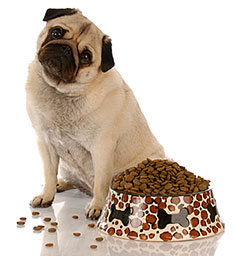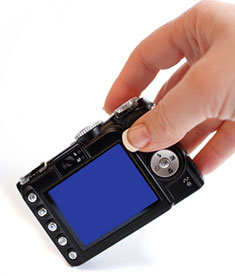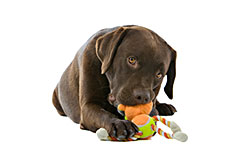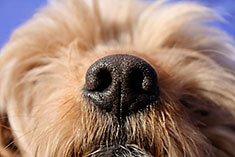Top Ten Tips for Taking Great Photos of Your Dog
How many times has your dog done something really sweet or funny, but the picture you took of the event was just horrible? Maybe the eyes were red or the nose looked too big in proportion to the rest of the body. Perhaps the dog wouldn't hold the pose long enough for you to get a good picture. Or maybe your child walked into the frame just before you got the shot off. While we can't help you with keeping your kids out of the way, here is a list of ten tips you can use to make every shot count.
1. Train and socialize your dog ahead of time
Generally speaking, the better trained your dog is, the better your photographs will turn out. If you are taking candid action shots of your dog playing, this may not be as vital, but for posed shots, training is an important prerequisite. Your dog simply must understand and be willing to obey your sit, stay, stand, and down commands in order for you to compose the picture.

Beyond these basic commands, you may be able to train your dog to look at you on command. Using standard training techniques such as praise and small treats, you can teach your dog to “look here” or “watch me”, which can be of great help if you want to get a full face picture of the dog.
In addition, your dog needs to be socialized so that he or she is familiar with any other subjects who may be in the photo. The more experience your dog has with different people and different situations, the better behaved he or she will be when it comes time to take pictures.
2. Take advantage of your camera's features
Of course, getting the correct lighting for your photo is important and can be accomplished by means of your camera’s flash, but many cameras have additional features which can make pet photography more successful.
For example, if your camera includes burst capability, it will allow you to rapidly fire off a “burst” of shots, increasing the likelihood that at least one of them will capture your dog doing whatever it is you wanted, particularly if the dog is in motion.
Your camera’s instruction manual will tell you whether or not it has a burst mode and how fast the shutter speed is when set to burst. A lower number indicates a faster shutter speed. Sometimes this is adjustable, so you should experiment with it to find what works best for you.
The newest generation of digital cameras also include a single-lens reflex (SLR) system which allows the view you see through the viewfinder to more closely mirror what you will see in the final picture. Many of these cameras also include a “sport mode” that can be useful in photographing your dog when he or she is in motion.
3. Use toys
Toys make wonderful props for pictures. If you can catch your dog snuggling with a plush toy or nibbling on the edge of a bone, it can help you to capture the dog’s personality as well as his or her good looks.

In addition, toys can be held up behind the camera to get the dog’s attention focused in your direction as you take the photo.
Finally, if you want to get some shots of your dog running, there is no better way to do this than to throw a Frisbee for the dog to chase. You may even be able to catch the dog jumping up to catch the disc.
4. Use a helper
Most professional photographers have an assistant. This isn’t just a status symbol. It reflects the fact that photography is hard work! As the person behind the camera, you will have to juggle your equipment, check the lighting, find good backgrounds, and compose your shots. It makes the job much easier if someone else is managing the dog.
Make sure your helper is someone the dog knows so you won’t have to waste time getting the dog comfortable with the assistant. If your helper is familiar with dogs and can authoritatively but positively control the dog, so much the better.
Your assistant should be advised ahead of time what you are trying to accomplish. The helper can be of the greatest use if he or she knows whether you want an action shot, a calm pose, or something in between. The helper can also position your dog correctly if he or she knows which angle you plan to use to capture a specific background.
5. Take lots of pictures
Even the best photographers don’t get the look they want with every shot they take. One of the key advantages to digital cameras is the ability to delete the pictures that don’t turn out the way you had hoped, keeping only the best of the lot. Make sure you keep extra batteries and film or memory cards on hand so you can keep shooting.

Taking a large number of pictures will assure that you will have some good ones, even if your ratio of bad to good is relatively high. Take some shots close up and some from a distance to give yourself a variety of poses to choose from.
That said, be sure not to wear out your dog. This is particularly important when you are taking action shots. Your dog will eventually have his or her tongue hanging out and be unwilling or unable to continue performing if you make your photo shoot too long. For calm shots, a dog may not be willing to hold a position for long periods while you take frame after frame of a certain pose.
6. Get your dog used to the camera's sounds, props, other people in the picture
Before you get started with a photo session, allow the dog to sniff the camera and check it out. If you will be using a flash, turn it on so the dog can get used to it. Many flash systems have a high-pitched whine which may distract your dog. Shoot off the flash with the camera pointed away from the animal several times so the dog hears the noise and sees the flash in a non-threatening way. If you are using a film camera, take these trial shots before you load the camera to prevent film waste.

If you will be using props, people, or other animals in the picture, make sure you give your dog time to get used to them. This is particularly important if you will be using animals. You really don’t want lots of photos of your dog eating your child’s bunny.
It may take quite a long time to introduce your dog to another animal. It is best to introduce animals with a fence or some other barrier between them until you learn how they will react to each other. Photographing them together should only be undertaken once you are certain that they are comfortable with each other.
Obviously, if your spouse and / or kids will be the only other subjects of the pictures, your dog will be perfectly comfortable and will not need special socialization activities. However, if you will be taking him or her to get pictures with Santa or the Easter Bunny, you will need to take this extra step to make sure the dog is comfortable with strangers. If the photos will be taken at a pet shop, you will also want to use socialization training to make sure your dog doesn’t freak out at the first sight of a lizard, rabbit, or another dog.
7. Frame and pose the picture appropriately
Have you ever seen those comical photos of a dog with a really huge nose? These are not necessarily Photo-Shopped; they may have just been taken with a different perspective. If the dog is particularly long and you take the photo very close to the face, the tail end of the dog will look very small in comparison to the head. To prevent this, make sure you are far enough away from your subject, and take the picture at an angle rather than face-on.

Taking the picture from above is generally not a great idea. Get down on your knees, or even on your stomach for a small dog, in order to get a good perspective on your dog. This will allow you to capture his or her facial expressions much more clearly because the dog will not be straining to look up at you.
If you are taking the picture from the side of a standing dog, make sure you can see all four legs.
8. Check out the background and lighting
The best background is one that contrasts with your dog’s coloring. For example, standing a black lab in front of a black background will likely show you only the dog’s eyes.
Look for backgrounds that are not too busy. Indoors, this may be a wall that is painted or conservatively papered, rather than a couch with a floral pattern. Outdoors, a plain background such as a sandy beach or a meadow may make a great background.
Make sure you check the area around your dog before you decide you have all the shots you need. You may have the perfect shot of your dog, but there may be a bush growing from your dog’s head or there may be someone standing in the background doing something inappropriate. It’s easy to get focused only on the subject of the portrait without double-checking to see what else you have included.
Using the portrait setting of your camera (if it has one) can allow you to blur the background while keeping the dog in focus.
A note about lighting: the best light is natural light, preferably overcast rather than bright sunshine. In bright sunshine, you will have to deal with shadows, which may obscure your dog’s beautiful face. If you must shoot on a sunny day, try to take the pictures in a shady area. Shooting in the morning or late evening may also help.
If the overcast is too thick, your photo will turn out too dark. For heavily overcast days and for inside shots, your flash apparatus should be separately attached, not built into the camera. Built-in flashes are often the cause of red eye. Separately attached flashes should be pointed at the ceiling, allowing the light to bounce down onto the scene rather than shining directly on the dog.
9. Be patient / pick the right time
Although you may have found the perfect day to take pictures and you may have all the time in the world to get the job done, your dog may simply not be in the mood to sit still that day. Make sure the dog thinks it is a wonderful time to take pictures before you start. Otherwise, you will be fighting an uphill battle.
If you want action shots, schedule the photo shoot after your dog takes a nap. If you want calm poses, take your dog out for a run in the park before you begin shooting.
10. Experiment / be flexible
Try taking pictures in different settings, from different angles, and in different poses or actions. The more variety you introduce to the process, the more fun it will be for your dog and the greater your likelihood of getting the shots you want.
Your dog’s first photo session may not produce any keepsake photos, but that doesn’t mean it’s a lost cause. Continue using short, fun sessions to get your dog used to the idea. You will eventually end up with the shots you want to keep.
After you have taken your pictures, be creative in experimenting with cropping and other features available on your computer if you have used a digital camera.
Once you have printed your final product, keep in mind that no one else loves your dog like you do. One or two photos of the dog will probably satisfy most people, so be selective in how many pieces of your prized photography you display at any one time.
Doggies Den: Latest Articles
 Homemade Thanksgiving Treats for Your Dog
Homemade Thanksgiving Treats for Your Dog
NUTRITION We all want to include our dogs in our holiday celebrations, but hopefully, you're aware that sharing table scraps with your dog isn't always the best idea.
 Keeping Your Dog Safe during the Summer Months
Keeping Your Dog Safe during the Summer Months
HEALTH Summer is coming on fast, so it’s time to plan how you will keep your dog safe and healthy through the lazy, carefree, warm days.
 Vaccination Time Again-Keeping Your Puppy Healthy
Vaccination Time Again-Keeping Your Puppy Healthy
DOG HEALTH So you have your new puppy picked out. There are quite a few shots, treatments and examinations that will keep the newest member of your family healthy.
 Canine Thanksgiving Feast
Canine Thanksgiving Feast
NUTRITION With the wide variety of food at Thanksgiving dinner, chances are you'll want to give your dog something special, too. If you're contemplating what to feed your dog for the holiday, here is a guide to a great Canine Thanksgiving Feast.
 Dog Walking Tips Every Owner Should Know
Dog Walking Tips Every Owner Should Know
DOG FUN Walking your dog is not only crucial to keeping him healthy and happy, it strengthens the bond between your canine friend and his caregiver. There are a lot of obstacles out there. Don’t forget these simple tips to keep your walk fun and safe in the outside world.
 The Benefits of Physiotherapy for your Dog
The Benefits of Physiotherapy for your Dog
HEALTH The same techniques that physiotherapists use to treat a variety of injuries and conditions in humans have been adapted to suit animals with great success. Family pets, show dogs, and working dogs can all benefit greatly from physiotherapy. Dogs whose activities involve a lot of agility are especially susceptible to the types of problems that physiotherapy can address.
 The Decision- Adding a Dog to Your Family
The Decision- Adding a Dog to Your Family
FIRST TIME OWNERSBringing a dog into your family is a decision where many people don’t realize it’s magnitude until after they have the dog. There are a number of things that you need to research before you decide to purchase a dog, and it starts right in your own home.
 Bringing Your Dog Into Your New Baby's Life
Bringing Your Dog Into Your New Baby's Life
HEALTH Many believe that a dog and a new baby cannot happily coexist, so therefore the dog has to go. This is not necessarily the case.  A new baby does not mean you have to abandon your dog.

Doggies Den:
Most Popular Articles

Dog Pregnancy Symptoms
HEALTHIf you suspect your dog might be pregnant, check out part one in this series on pregnant dogs, where we cover pregnant dog symptoms.

Dog Birth
HEALTHIn the third article of our dog pregnancy series, we look at the wonderful, but messy, process of bringing newborn puppies into the world.

Indoor Dog Potties
DOG PRODUCTSIt's been a long day at work. You were so busy, you didn't even take time to eat a sandwich, let alone run home to let your dog out. You're on your way home, knowing the poor dog is crossing his or her legs by now, when your car breaks down, delaying you even further. Can't somebody make this easier?

Your Dog’s Digestive System
PHYSIOLOGYEver wonder why your dog eats so fast? Or why he eats gross things? Or why he gets sick to his stomach? Or why his waste stinks so bad? Some of these things are normal, some are not.

Canine Respiratory System
BREATHINGThe basic function of your dog's respiratory system is to bring oxygen in to and remove carbon dioxide from the body. Knowing the symptoms of respiratory diseases can help you help your stay healthy.

Shelter Dog Adoption Tips for Success
ADOPTION Are you intimidated by the prospect of "rescuing" a dog from a shelter? One reason that you may be wary of adopting a dog from a shelter is not knowing how to choose. Adopting a dog from a shelter can be a rewarding process, if you're prepared to do a reasonable amount of research.

Canine Urinary Tract Infections
SYMPTOMS AND TREATMENTDoes your dog seem to be having trouble relieving his or her bladder? Learn how to recognize the signs of urinary tract infections and how to treat them before they spread.

What to do for Dog Diarrhea
SYMPTOMS AND REMEDIESIf you have dogs in your house for any length of time, you have likely experienced at least one bout of dog diarrhea. Beyond the pain in the tuckus involved in cleaning up the mess, you should know what causes diarrhea, and when it's important to see the vet.

What to do for a Dog Bite
DOG BEHAVIOR Getting bitten by a dog can be scary, and you may be tempted to run around in circles for a while, trying to figure out what to do. Here's our guide to help you manage the situation.

Top Ten Tips for Living with a Senior Dog
DOG HEALTH Bringing home a new puppy is so exciting, but it doesn’t take all that long for your exuberant puppy to grow into a senior dog who may have special needs. Here are the doggies.com top ten tips for taking care of your companion who has been with you through so much.
